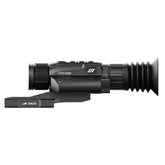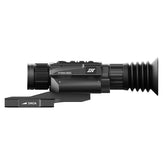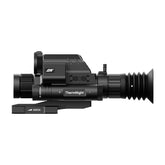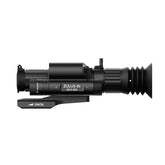The Evolution and Future of Night Vision Scopes
Author: Nicholas C
Thank you for joining us here at DNT and we welcome you to learn more about Night Vision. Here at DNT Optics, we are passionate about creating products that enhance and augment your ability to see in the dark. But to truly appreciate how far we have come, let us take a stroll down memory lane.
From Firelight to Gen 0: The Birth of Night Vision
Humankind has evolved and one of the earliest inventions to help us see in the dark was fire. Fire has a lot of properties like helping us to stay warm when the environment is cold. It also helps to cook our food but just as important, fire helps illuminate the darkness at night. Humans have a natural fear of the unknown and that includes the dark. We need to see what is lurking at night that could possibly harm us. So for thousands of years we relied on burning materials to create fire which also produces light as a byproduct.
However it wasn’t until the second World War, that humans started to explore other spectrums of light for weapon use. Specifically the infrared spectrum of light. The first night vision scope was invented by the Germans in the 1930s. It did not amplify light but instead relied on active illumination. This is the birth of Gen 0 night vision systems. A special light was used to produce infrared light. The Gen 0 scope could see this light and show the shooter what lurks in the dark. By utilizing the infrared spectrum, it is invisible to our naked eyes giving the user the advantage. While the Gen 0 night vision systems worked, they were big and bulky. But more importantly they did not amplify light.



Gen 0
Gen 1: Light Amplification and the Starlight Scope
The US began creating actual light amplification systems and gave birth to Gen 1 night vision. This technology was utilized in the Vietnam War in the Starlight Scope. Some companies created cascade tubes which stacked multiple image intensifiers to boost their performance. Some Gen 1 cascade tubes look similar, in performance, to Gen 3 night vision with regards to their light amplification. However these systems did not have any auto gating or auto brightness control.

Gen 1: The U.S. Army AN/PVS-2

Gen 1: An M16A1 rifle fitted with the AN/PVS-2 Starlight scope
Gen 2 & Gen 3: The Peak of Analog Night Vision
By the 1970s the US and other countries continued to experiment with different materials and developed Gen 2 night vision. The form factor of the image intensifier tube became smaller which allowed night vision goggles to be smaller and lightweight enough to be worn on the head.

Gen 2: A cut-open and depotted AN/PVS-5, showing the components of a night-vision device
The US further developed their image intensifier technology to create Gen 3 image intensifiers. Performance increased significantly but according to industry experts, analog night vision has reached the end of its evolutionary cycle. To that end we see companies experimenting with digital systems to augment vision and see in the dark. One direction we have seen is the creation of EBAPS, Electron Bombarded Active Pixel Sensor. Rather than using a phosphor screen to display the amplified light, they replaced it with a CMOS sensor. They are still using analog image intensifier technology to amplify light but by using a CMOS sensor, they can send the digital image to a screen as well as integrate the signal with other digital systems.

Gen 3: An early development version of the AN/PVS-7 goggle

Gen 3: An AN/PVS-14 night vision device
Digital Night Vision: A New Era with CMOS, EBAPS, and Expanded Capabilities
In 2014 we saw the first step in the evolutionary ladder for low light sensitivity in a digital CMOS system. The Sony A7S mirrorless digital camera was able to see in the dark without the aid of active illumination. Just like analog night vision, these digital sensors did need a modicum of ambient light to see, such as a full moon. It is only recently we have seen newer digital CMOS systems nipping at the heels of analog night vision in terms of light amplification.
While analog night vision is still the reigning king in terms of light amplification and energy efficiency, there are some significant advantages to digital night vision. Just like the EBAPS systems, you can easily integrate a digital image with other digital systems like thermal sensors, laser range finders, and ballistic calculators. You can record these digital signals and even beam them wirelessly to viewing devices like a smart phone. We are seeing digital systems becoming more efficient and their performance is still evolving.
Another added advantage that digital night vision has over analog night vision is the sensitivity to out of band wavelengths of light. Analog night vision sensitivity starts to drop off around 940nm and in some cases 1064nm. Digital CMOS night vision systems can see light all the way to 1200 nm. If utilized properly, you can use infrared illuminators and infrared lasers that emit photons in those higher wavelengths. Analog night vision will struggle to see anything past 1064nm, while digital night vision can see it clearly.

The Future of Night Vision Scopes: ZULUS HD and the Path Ahead
The future of night vision, and specifically scopes, looks bright. Digital night vision is easier and cheaper to manufacture, thus making night vision more accessible. More and more people can now “own the night”.
The ZULUS HD series is one of the key tools making that vision a reality. With a high-resolution 1920×1080 micro-OLED display running at 60Hz, it delivers sharp, real-time visuals without blur. Its digital zoom, intuitive controls, and lightweight yet rugged design make it dependable across all environments, from open terrain to dense brush. Fully waterproof and shock-resistant, it allows hunters and shooters to move with clarity and confidence in the dark.
But progress doesn’t stop here. This July, we will introduce the ZULUS HD V2, a refined evolution shaped by real-world feedback. With improved usability, longer endurance, and enhanced display performance, it is built to meet the demands of those who expect more after every mission. Stay tuned.
Explore the ZULUS HD Series: https://us.dntoptics.com/collections/night-vision








Leave a comment
Please note, comments need to be approved before they are published.